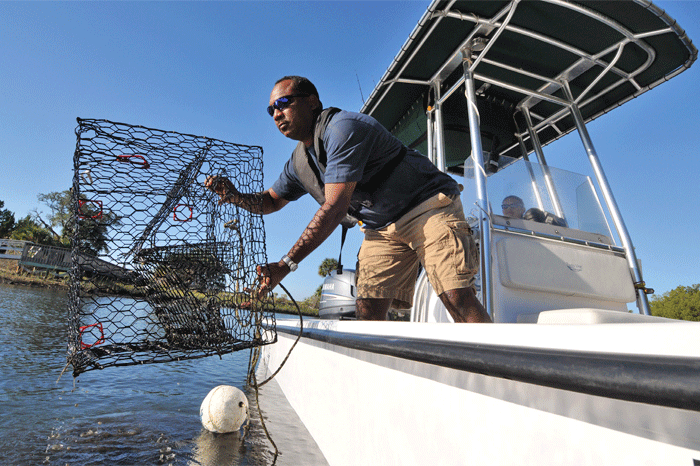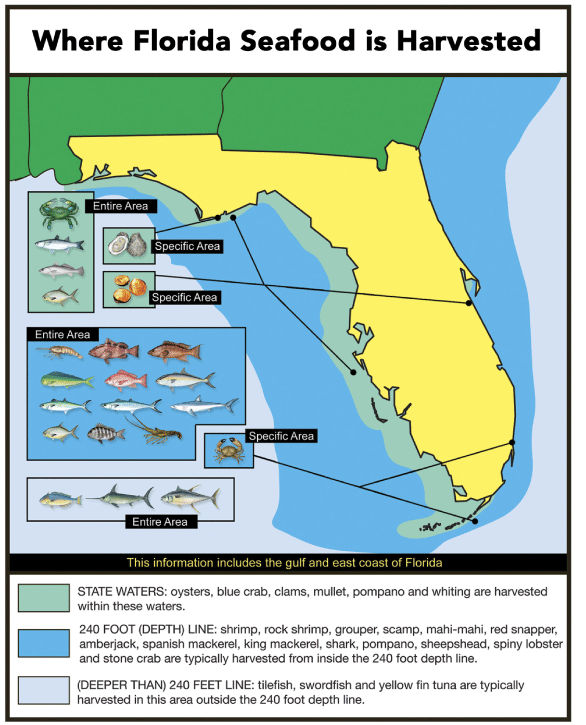Can Florida’s seafood industry help start a new chapter in America’s seafood intake?
“ONE FISH, two fish, red fish, blue fish.” This Dr. Seuss classic is one a lot of us grew up on, passing it down from generation to generation. But there is an important lesson to be learned through this short tale … or should we say, tail? Seuss may not have known it at the time, but seafood is meant to be a vital part of our weekly diets. And while the following information won’t rhyme or be accompanied by pictures of starred fish, it will help families live a healthier lifestyle.
According to the Agricultural Research Service (ARS), the U.S. Department of Agriculture’s chief scientific in-house research agency, people have the wrong idea about seafood. The ARS found that “about 80 to 90 percent of U.S. consumers did not meet their seafood recommendations.” This new study follows the Food and Drug Administration’s 10-year “Quantitative Assessment” that concludes what America needs to eat more of is … fish.
But why should we care? While it’s quite common to believe one should lessen their current intake of fishy foods, it’s been found that your body actually needs the natural compounds that can be found in seafood. It needs omega-3 fatty acids, to be exact. ARS research found that two omega-3s — EPA (eicosapentaenoic acid) and DHA (docosahexaenoic acid) — can be found in oily fish such as salmon, mackerel, herring, sardines, anchovies, trout, and tuna. Since our bodies don’t naturally produce these acids, we have to get them through the foods we consume. The 2010 Dietary Guidelines for Americans recommend eating two servings weekly in order to get at least 1,750 milligrams of EPA and DHA per week.
Still need convincing? The American Heart Association also recommends eating two servings of fish a week because they’re filled with protein, vitamins, and nutrients that can help lower blood pressure and reduce the risk of a heart attack or stroke. You can visit http://www.heart.org/HEARTORG/General/Fish-and-Omega-3-Fatty-Acids_UCM_303248_Article.jsp for more information about the benefits of fish intake.
Now, let’s assume that you’re convinced and that you’re craving something under the sea … where can you go to get your seafood fill? You’re in the right state! According to the Florida Department of Agriculture and Consumer Services, “Florida ranked among the top 12 states in 2012 for fresh seafood production with over 93 million pounds harvested and a dockside value of more than $205 million.” With more than 80 types of seafood harvested off Florida’s coasts, it’s not hard to locate some fresh seafood, all while supporting local fishing families. You can find a list of seafood retail markets, online and mail order sellers, and retail grocery chains at http://www.freshfromflorida.com/Divisions-Offices/Marketing-and-Development/Consumer-Resources/Buy-Fresh-From-Florida/Seafood-Retail-Markets.
“Yes. Some are red. And some are blue. Some are old. And some are new.” Whatever type of fish you choose to consume, know that you are doing your body good. Join the state of Florida in changing the amount of seafood we eat by getting it fresh from your closest seafood market.
CFAN TIP
Here’s a list of Florida seafood that’s in the peak months of availability right now!
• Alligator – Available year-round, alligator meat is usually purchased frozen, but it is also available fresh. Thaw frozen meat in the refrigerator and use promptly.
• Blue Crab – With peak months of availability running from May to October, blue crab is one of Florida’s top 10 seafood products in dockside value and ranks in the top five in terms of pounds harvested.
• Clams – Florida hard clams are harvested year-round and are always available in steady supply. Though some clams are still wild caught, clam farming is a growing industry.
• Flounder – There are three main species of flounder commercially harvested in Florida, and peak months of availability run from May to November.
• Grouper* – Although Grouper is always on the menu at Florida seafood restaurants, you’ll find them in peak supply during the warm months, from April to October.
• Mullet – As one of old Florida’s signature flavors, Mullet is a staple that’s available year-round, but supply is greatest in late fall when the fish form huge schools and migrate from shallow coastal waters into deeper waters to spawn.
• Oysters – Florida oysters are available year-round, but harvest really gears up in fall as water temperatures begin to drop. Fall and winter are the perfect time to enjoy Florida’s famous oysters.
• Snapper-Red* – Florida’s most prized food fish is at its peak from December to June.
• Snapper-Others – Available year-round, look for many variety of snappers at your local market.
• Shrimp – The next time you’re in the market for seafood, support your hardworking local shrimpers and choose Florida wild-caught shrimp. Wild-caught shrimp is available year-round, but supplies are at their peak from June through December.
• Spiny Lobster – One of Florida’s top commercial seafood products in dockside value, the season runs from August through March.
• Swordfish – Found throughout the world including Florida’s Gulf and Atlantic waters, swordfish peak here from September through November.
• Tilapia – Available year-round, Florida has a wild fishery of tilapia found in Central Florida lakes and Tampa Bay’s brackish water estuary that are sold in regional seafood retail shops as fresh, gutted fish.
• Tilefish* – Two types of tilefish are plentiful in Florida waters: the golden tilefish (Lopholatilus chamaeleonticeps) and the blueline or gray tilefish (Caulolatilus microps).
• Yellowfin Tuna – Available year-round, June through August are months of peak supply.
*Availability subject to quota closure.
NOTE: Most Florida seafood products are available frozen year-round.
Resource: Florida Department of Agriculture and Consumer Services
CREDIT
article by ANDREA REEVES


